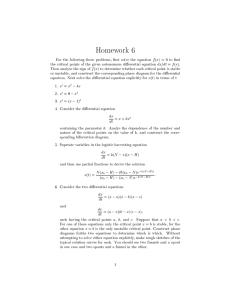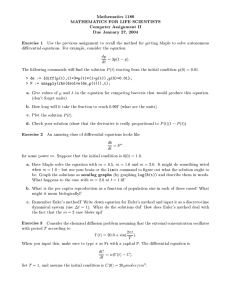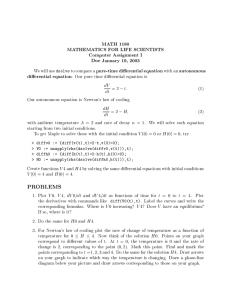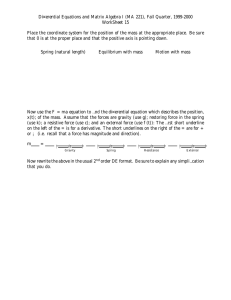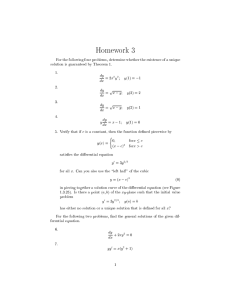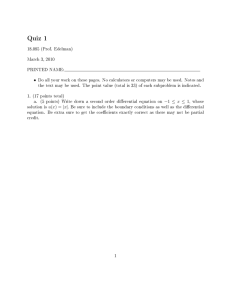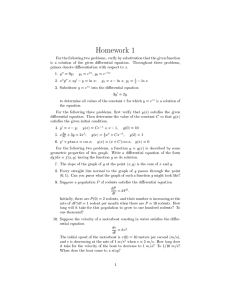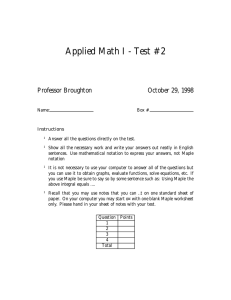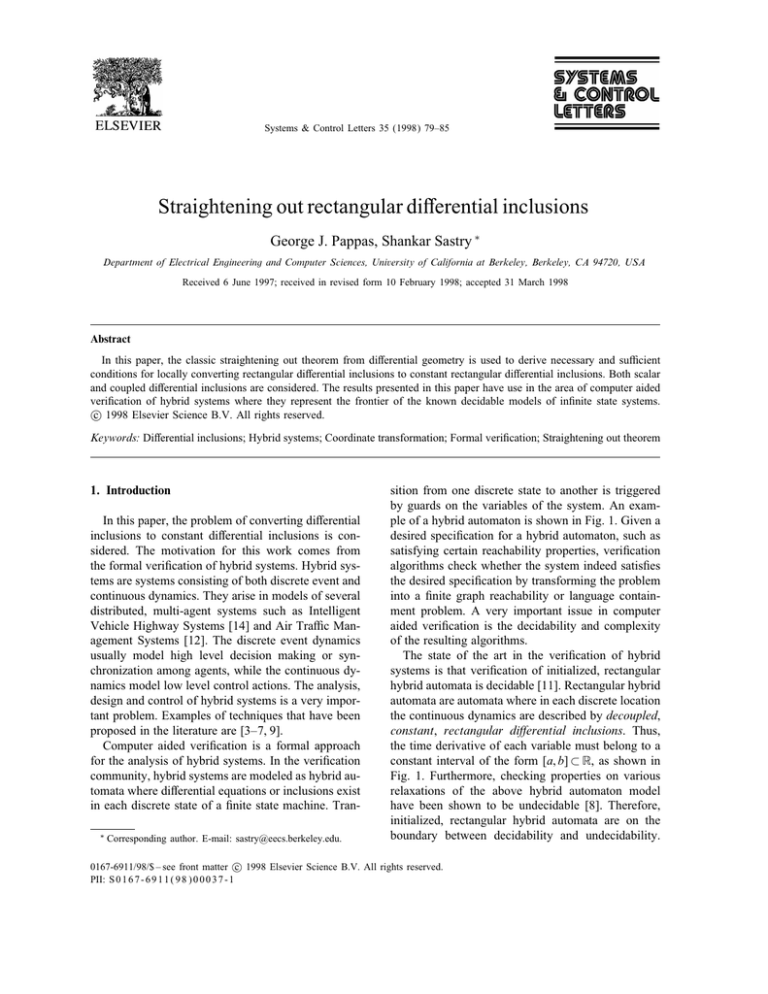
Systems & Control Letters 35 (1998) 79–85
Straightening out rectangular dierential inclusions
George J. Pappas, Shankar Sastry ∗
Department of Electrical Engineering and Computer Sciences, University of California at Berkeley, Berkeley, CA 94720, USA
Received 6 June 1997; received in revised form 10 February 1998; accepted 31 March 1998
Abstract
In this paper, the classic straightening out theorem from dierential geometry is used to derive necessary and sucient
conditions for locally converting rectangular dierential inclusions to constant rectangular dierential inclusions. Both scalar
and coupled dierential inclusions are considered. The results presented in this paper have use in the area of computer aided
verication of hybrid systems where they represent the frontier of the known decidable models of innite state systems.
c 1998 Elsevier Science B.V. All rights reserved.
Keywords: Dierential inclusions; Hybrid systems; Coordinate transformation; Formal verication; Straightening out theorem
1. Introduction
In this paper, the problem of converting dierential
inclusions to constant dierential inclusions is considered. The motivation for this work comes from
the formal verication of hybrid systems. Hybrid systems are systems consisting of both discrete event and
continuous dynamics. They arise in models of several
distributed, multi-agent systems such as Intelligent
Vehicle Highway Systems [14] and Air Trac Management Systems [12]. The discrete event dynamics
usually model high level decision making or synchronization among agents, while the continuous dynamics model low level control actions. The analysis,
design and control of hybrid systems is a very important problem. Examples of techniques that have been
proposed in the literature are [3–7, 9].
Computer aided verication is a formal approach
for the analysis of hybrid systems. In the verication
community, hybrid systems are modeled as hybrid automata where dierential equations or inclusions exist
in each discrete state of a nite state machine. Tran∗
Corresponding author. E-mail: sastry@eecs.berkeley.edu.
sition from one discrete state to another is triggered
by guards on the variables of the system. An example of a hybrid automaton is shown in Fig. 1. Given a
desired specication for a hybrid automaton, such as
satisfying certain reachability properties, verication
algorithms check whether the system indeed satises
the desired specication by transforming the problem
into a nite graph reachability or language containment problem. A very important issue in computer
aided verication is the decidability and complexity
of the resulting algorithms.
The state of the art in the verication of hybrid
systems is that verication of initialized, rectangular
hybrid automata is decidable [11]. Rectangular hybrid
automata are automata where in each discrete location
the continuous dynamics are described by decoupled,
constant, rectangular dierential inclusions. Thus,
the time derivative of each variable must belong to a
constant interval of the form [a; b] ⊂ R, as shown in
Fig. 1. Furthermore, checking properties on various
relaxations of the above hybrid automaton model
have been shown to be undecidable [8]. Therefore,
initialized, rectangular hybrid automata are on the
boundary between decidability and undecidability.
c 1998 Elsevier Science B.V. All rights reserved.
0167-6911/98/$ – see front matter PII: S 0 1 6 7 - 6 9 1 1 ( 9 8 ) 0 0 0 3 7 - 1
80
G.J. Pappas, S. Sastry / Systems & Control Letters 35 (1998) 79–85
Fig. 1. Rectangular hybrid automaton.
It has also been recognized, mainly in the control
community that is used to more sophisticated dynamical models, that the expressive power oered by a
rectangular hybrid automaton is limited.
In an eort to expand the applicability of the decidability results just stated, we ask the natural question
of when can we convert more general hybrid systems
with more complicated dynamics in each discrete location to a hybrid system with decoupled, constant,
dierential inclusions? In addition, an answer to this
question would also be useful as it could characterize
the modeling frontier for the known decidability and
undecidability results. Along this direction, in this paper we consider the following continuous version of
this problem.
Problem 1 (Straightening out coupled, rectangular differential inclusions). Under what conditions can a
coupled, rectangular dierential inclusion of the form
ẋ1 ∈ [ f1 (x1 ; : : : ; xn ); g1 (x1 ; : : : ; xn )]
..
.
ẋn ∈ [ fn (x1 ; : : : ; xn ); gn (x1 ; : : : ; xn )]
where x = [x1 ; : : : ; xn ]T ∈ U ⊆ Rn , f1 ; : : : ; fn ; g1 ; : : : ; gn
are smooth maps from U to R, and for each 16i6n
and for all x ∈ U , gi (x)¿fi (x) be converted by a
smooth coordinate change z = (x) to a decoupled,
constant, rectangular inclusion of the form
ż 1 ∈ [a1 ; b1 ]
..
.
obtain conditions for converting decoupled, scalar
rectangular inclusions. In Section 2, we review the
necessary dierential geometric tools and two versions of the straightening out theorem for dierential
equations. They will be used in Section 3, where
necessary and sucient conditions for the solvability
of Problem 1 are derived. Finally, Section 4 contains
conclusions.
2. Straightening out dierential equations
Let Tx Rn denote the tangent space at x ∈ Rn . Let
ei = [0; : : : ; 1; : : : ; 0]T with 1 at the ith position and
e1 ; : : : ; en be the standard, orthonormal basis for
Rn . For smooth map : Rn → Rm with x ∈ Rn and
z = (x), we push forward tangent vectors from Tx Rn
to Tz Rm using the induced push forward map ∗
which is a linear map. A smooth vector eld on Rn is
a smooth map f which places at each point x ∈ Rn a
tangent vector f(x) ∈ Tx Rn . Given a dieomorphism
: Rn → Rn and a smooth vector eld f on Rn , we
naturally dene the vector eld ∗ (f) by pointwise
assigning the tangent vector ∗ (f(x)) at (x). The
Lie bracket of two vector elds f and g on Rn is
denoted by [ f; g] 1 and given by
[f; g] =
@g
@f
f − g:
@x
@x
The Lie bracket commutes with the push forward map
∗ of a dieomorphism , thus
∗ ([f; g]) = [∗ (f); ∗ (g)]:
(2)
We now present without proof the Rn version of the
Theorem 1 (Flow box or straightening out theorem).
Let f be a smooth vector eld on Rn with f(x0 ) 6= 0
at some x0 ∈ Rn . Then there exists a neighborhood U
of x0 and a change of coordinates z = (x) such that
for all z ∈ (U ); ∗ (f) is expressed as
∗ (f) = e1 :
ż n ∈ [an ; bn ]
Thus, given a dierential equation of the form
where ai , bi are real constants for all 16i6n?
ẋ = f(x);
In this endeavor, a generalized version of the
straightening out (or ow box) theorem will be used
in order to derive necessary and sucient conditions
for the solution of Problem 1. As a corollary, we will
(1)
(3)
where x ∈ Rn and f : Rn → Rn is smooth, then away
from equilibria, f(x) 6= 0, there exists a local change
1 Note that [·; ·] is used to denote both Lie brackets as well as
intervals. The usage will be clear from the context.
G.J. Pappas, S. Sastry / Systems & Control Letters 35 (1998) 79–85
of coordinates z = (x) such that in the z coordinates
the dierential equation is expressed as
ż 1 = 1; ż 2 = 0; : : : ; ż n = 0:
(4)
Note that the straightening out theorem is a local and
non-constructive result. Obtaining the desired dieomorphism usually involves explicit integration of
the system since the change of coordinates is simply the time parameterization of the integral curves
(z1 ) along with the leaves of the resulting foliation
(z2 ; : : : ; zn ) which is induced by integrating the system.
Theorem 1 is already interesting in that it allows transforming dierential equations away from equilibria to
equations with constant rates or clocks. The ow box
theorem could therefore be used in converting hybrid
systems with the same dierential equation in each
discrete location to timed automata, which is a decidable class of systems [2]. In the case where dierent
vector elds are present in dierent discrete states, the
following theorem which can be considered a generalization of Theorem 1 for multiple vector elds is
useful.
Theorem 2 (Straightening out multiple vector elds).
Let f1 ; : : : ; fk be k smooth, linearly independent vector elds in a neighborhood of x0 ∈ Rn satisfying
[fi ; fj ] = 0;
16i; j6k:
(5)
Then there exists a change of coordinates z = (x)
and a neighborhood U around x0 ∈ Rn , such that
∗ ( fi ) = ei
(6)
which simply says that the ows of the vector elds
commute, is necessary in order for the change of coordinates to be well dened. More important though,
in the new coordinates, the vector elds in addition to
being straightened out are also decoupled.
A much more detailed exposition of the above material may be found in numerous dierential geometry
books such as [13, 1].
3. Straightening out dierential inclusions
as
In general, a dierential inclusion on Rn is dened
ẋ ∈ F(x);
(8)
where F is a map which at each x ∈ Rn assigns a subset of Tx Rn . Given a smooth change of coordinates
: Rn → Rn and dierential inclusion (8), we can naturally push forward the dierential inclusion by pointwise assigning to each z = (x) the push forward of
all tangent vectors belonging in F(x). Thus
ż ∈ ∗ (F(x))
(9)
is the dierential inclusion resulting from the change
of coordinates. In this paper we focus on rectangular
dierential inclusions of the form
ẋ1 ∈ [ f1 (x1 ; : : : ; xn ); g1 (x1 ; : : : ; xn )]
..
.
(10)
ẋn ∈ [ fn (x1 ; : : : ; xn ); gn (x1 ; : : : ; xn )]
for all 16i6k and for all z ∈ (U ).
Therefore given n dierential equations of the form
ẋ = fi (x);
where 16i6n, x ∈ Rn and fi : Rn → Rn are smooth,
then at any x0 ∈ Rn where the vectors {fi (x0 )}ni=1 is a
linearly independent set 2 and the Lie bracket conditions hold, there exists a local change of coordinates
z = (x) such that in the z coordinates the ith dierential equation is expressed as
ż 1 = 0; : : : ; ż i = 1; : : : ; ż n = 0:
81
(7)
Like the Flow Box Theorem, Theorem 2 is also local and non-constructive. The Lie bracket condition,
2 Note that linear independence at x requires that x is not
0
0
an equilibrium of any of the n vector elds. By smoothness, the
linear independence condition extends to a neighborhood of x0 .
where the derivative of each coordinate lies in an interval. We are now ready to proceed with the main
theorem.
Theorem 3 (Necessary and sucient conditions for
coupled rectangular inclusions). Consider the coupled, rectangular dierential inclusion in Rn ,
ẋ1 ∈ [ f1 (x1 ; : : : ; xn ); g1 (x1 ; : : : ; xn )]
..
.
(11)
ẋn ∈ [ fn (x1 ; : : : ; xn ); gn (x1 ; : : : ; xn )]
where x = [x1 ; : : : ; xn ]T ∈ U ⊆ Rn , f1 ; : : : ; fn ; g1 ; : : : ; gn
are smooth maps from U to R, and for each i and
for all x ∈ U we have gi (x)¿fi (x). Then there exists
a local change of coordinates z = (x) on U such
82
G.J. Pappas, S. Sastry / Systems & Control Letters 35 (1998) 79–85
that in the new coordinates the dierential inclusion
is expressed as
ż 1 ∈ [a1 ; b1 ]
..
.
(12)
ż n ∈ [an ; bn ]
if and only if for all x ∈ U and for all 16i; j6n,
[ fi (x)ei ; gj (x)ej ] = 0;
(13)
[ fi (x)ei ; fj (x)ej ] = 0;
(14)
and for all 16i6n and for all x ∈ U there exist
ki ∈ R, such that either
gi (x) = ki fi (x)
or
fi (x) = ki gi (x):
(15)
Proof. Before we begin with the proof, we remark
that conditions (13)–(15) contain some redundancy.
However, a minimal set of conditions would be notationally complicated.
(Necessity) A more convenient representation of
the rectangular inclusion (10) is given by the following expression
ẋ1
..
ẋ = . ∈ F(x)
ẋn
= F1 (x) + F2 (x) + · · · + Fn (x);
(16)
0
0
.. ..
. .
; gi (x)
(x)
f
Fi (x) = co
i
.. ..
. .
0
0
= co{fi (x)ei ; gi (x)ei };
where Zi is the constant interval
0
0
.. ..
. .
bi
ai
Zi = co
;
= co{ai ei ; bi ei }:
.. ..
. .
0
0
(21)
Note again that for i 6= j, any vector from Zi is linearly
independent from any vector in Zj . By assumption we
then have that
ż ∈ ∗ (F1 (x)) + ∗ (F2 (x)) + · · · + ∗ (Fn (x))
= Z 1 + Z2 + · · · + Zn :
(22)
Since for all i 6= j, vectors in ∗ (Fi (x)) (also Zi ) are linearly independent from vectors in ∗ (Fj (x)) (respectively Zj ) then Eq. (22) requires that for each i there
exists some ji such that ∗ (Fi (x)) = Zji . Therefore, up
to a permutation of the indices, the sets ∗ (Fi (x)) are
equal to the sets Zi .
In general, for linear map A and vectors p1 ,p2 the
following property of convex hulls
(23)
can be easily checked. By applying this property on
Eqs. (19) and (17) we obtain that
∗ (Fi (x)) = ∗ (co{fi (x)ei ; gi (x)ei })
(17)
ż ∈ ∗ (F(x))
(18)
By the linearity of ∗ we have that
ż ∈ ∗ (F1 (x)) + ∗ (F2 (x)) + · · · + ∗ (Fn (x)):
ż n
Aco{p1 ; p2 } = co{Ap1 ; Ap2 }
where co{p1 ; p2 } stands for the convex hull of vectors p1 and p2 . Note that for i 6= j, any vector in Fi (x)
is linearly independent from any vector in Fj (x). Performing the change of coordinates z = (x) results in
= ∗ (F1 (x) + F2 (x) + · · · + Fn (x)):
Since ∗ is pointwise an isomorphism, we retain the
property that any vector from ∗ (Fi (x)) is linearly
independent from any vector in ∗ (Fj (x)) for i 6= j.
Now, by assumption, the change of coordinates results in inclusion (12) which is also expressed as
ż 1
..
(20)
ż = . ∈ Z = Z1 + Z2 + · · · + Zn ;
= co{∗ (fi (x)ei ); ∗ (gi (x)ei )}:
(24)
The above calculations essentially show that in order
to push forward a rectangular dierential inclusion,
one only needs to push forward the nite number of
vector elds that are needed to dene the rectangular
set of tangent vectors.
But since ∗ (Fi (x)) = Zji , condition (24) results in
co{∗ (fi (x)ei ); ∗ (gi (x)ei )} = co{aji eji ; bji eji } (25)
which means that either
(19)
∗ (fi (x)ei ) = aji eji
and
∗ (gi (x)ei ) = bji eji
(26)
G.J. Pappas, S. Sastry / Systems & Control Letters 35 (1998) 79–85
83
by ∗ results in
or
∗ ( fi (x)ei ) = bji eji
and
∗ (gi (x)ei ) = aji eji : (27)
Assume without loss of generality that the rst case
holds (Eq. 26). Then for all 06i; l6n,
∗ ([ fi (x)ei ; gl (x)el ]) = [∗ ( fi (x)ei ); ∗ (gl (x)el )]
= [aji eji ; bjl ejl ] = 0
(28)
which results in the necessary conditions
[ fi (x)ei ; gl (x)el ] = 0
for all 06i; l6n
(29)
since ∗ is pointwise an isomorphism. In a similar
manner one obtains
[fi (x)ei ; fl (x)el ] = 0
for all 06i; l6n:
(30)
In addition, since gi (x)¿fi (x), if fi (x) 6= 0 we can
express gi (x) as a nonlinear function of fi (x) by
gi (x) = ki (x)fi (x) (if fi (x) = 0 then express fi (x) as
gj (x) multiplied by zero and proceed in the same
way). Then
bji eji = ∗ (gi (x)ei ) = ∗ (ki (x)fi (x)ei )
= ki (x)∗ ( fi (x)ei ) = ki (x)aji eji
(31)
must hold for all x ∈ U . Thus ki (x) must be constant
and gi (x) must be a constant multiple of fi (x) for all
x ∈ U . Note that for each i either fi (x) or gi (x) can
be zero (but not both since gi (x)¿fi (x)). However, if
fi (x) or gi (x) is zero at some point x0 , say gi (x0 ) = 0
and fi (x0 ) 6= 0, then smoothness and the fact that gi (x)
must be a constant multiple of fi (x) for all x ∈ U ,
force gi (x) to be identically zero on U .
(Suciency) Consider conditions (13)–(15) and
assume without loss of generality that for all i
fi (x) 6= 0 (if fi0 = 0 for some i0 then pick gi0 which
must be nonzero and proceed in a similar way). Then,
the set of vector elds
{fi (x)ei }ni=1
(32)
satises the conditions of Theorem 2. Thus, there exists a dieomorphism z = (x) such that
∗ ( fi (x)ei ) = ei :
(33)
Now pushing forward the rectangular inclusion
ẋ ∈ F1 (x) + F2 (x) + · · · + Fn (x)
(34)
ż ∈ ∗ (F(x))
= ∗ (F1 (x) + F2 (x) + · · · + Fn (x))
= ∗ (F1 (x)) + ∗ (F2 (x)) + · · · + ∗ (Fn (x)):
(35)
But since for each i and for all x we have gi (x)= ki fi (x)
for some constant ki (positive, negative or zero), we
obtain
∗ (Fi (x)) = ∗ (co{fi (x)ei ; ki fi (x)ei })
= co{∗ (fi (x)ei ); ∗ (ki fi (x)ei )}
= co{ei ; ki ei }
(36)
and thus in the z coordinates we obtain the inclusion
ż 1 ∈ [1; k1 ]
..
.
ż n ∈ [1; kn ]
Note that some of the ki may be zero or even negative in which case the corresponding intervals must be
ipped. This completes the proof.
Note that the proof of Theorem 3 depends on the
fact that gi (x) ¿ fi (x) for all i. It is therefore not
a generalization of the straightening out theorem for
dierential equations.
Even though straightening out a dierential equation is always possible away from an equilibrium,
straightening out a rectangular dierential inclusion,
requires straightening out many vector elds, while
using the same change of coordinates. This places restrictions on the types of rectangular dierential inclusions that can be straightened out. The following
corollary shows how restrictive this class is.
Example. Consider the coupled dierential inclusion
ẋ1 ∈ [f1 (x1 ; x2 ); g1 (x1 ; x2 )];
ẋ2 ∈ [f2 (x1 ; x2 ); g2 (x1 ; x2 )];
where we have f1 (x1 ; x2 ) 6= 0 and f2 (x1 ; x2 ) 6= 0 on
some set U ⊆ R2 . Then conditions (15) require that
gi (x1 ; x2 ) is a constant multiple of fi (x1 ; x2 ). Thus necessary conditions (13,14) reduce to simply checking
whether
[f1 (x1 ; x2 )e1 ; f2 (x1 ; x2 )e2 ] = 0
(37)
84
G.J. Pappas, S. Sastry / Systems & Control Letters 35 (1998) 79–85
as all other Lie brackets are guaranteed to be zero if
the above one is. But
[ f1 (x1 ; x2 )e1 ; f2 (x1 ; x2 )e2 ] = 0
" @f #
1
@x2 f2
⇒
= 0:
@f2
@x1 f1
(38)
But since f1 6= 0 and f2 6= 0 on U , this requires
@f1
=0
@x2
@f2
=0
@x1
(39)
which means that it is necessary for the rectangular
inclusion to be already decoupled!
The above example suggests that the conditions of
Theorem 3 are quite restrictive. In the case that fi (x)
and gi (x) depend on xi alone, the Lie bracket conditions (13), (14) are trivially satised. As a corollary
of Theorem 3, we obtain the following straightening
out theorem for decoupled, rectangular inclusions.
Corollary 1 (Straightening out decoupled dierential
Inclusions). Consider the scalar dierential inclusion
ẋ ∈ [ f(x); g(x)]
(40)
with x ∈ U ⊆ R, f; g : U → R smooth, and assume
that for all x ∈ U we have g(x)¿f(x). Then there
exists a local change of coordinates z = (x) such
that in the new coordinates the dierential inclusion
is expressed as
ż ∈ [a; b]
(41)
if and only if for all x ∈ U either g(x) is a constant
multiple of f(x) 6= 0 or f(x) is a constant multiple
of g(x) 6= 0.
As a corollary of Corollary 1 we obtain
Corollary 2. The following scalar inclusions can be
locally transformed to constant rectangular dierential inclusions:
• Linear dierential inclusions: ẋ ∈ [a; b]x, x 6= 0:
• Nonlinear dierential inclusions: ẋ ∈ [0; f(x)],
f(x)¿0:
• Nonlinear dierential inclusions: ẋ ∈ [ f(x); 0],
f(x)¡0:
• Nonlinear dierential inclusions: ẋ ∈ [a; b]f(x),
f(x) 6= 0:
Corollaries 1 and 2 show that scalar rectangular differential inclusions cannot be straightened out unless
one boundary vector eld, g(x), is a constant multiple
of the other, f(x). This result is intuitively clear. By
Theorem 1, any vector eld, say f(x), can be straightened out away from singularities. But if the same diffeomorphism must also straighten the ows of the
other vector eld, g(x), then g(x) must be a constant
multiple of f(x). But if g(x) is a constant multiple of
f(x), then after factorization, we obtain that a dierential inclusion of the form ẋ ∈ [a; b]f(x) is the limiting case of an inclusion which can be straightened
out.
Example. Consider the following simple linear dierential inclusion in U = {x ∈ R | x¿0},
ẋ ∈ [3; 5]x
Note that z = ln x satises
@ ln x
1
ż =
ẋ ∈ [3; 5]x = [3; 5]
@x
x
and the inclusion is straightened out on U .
4. Conclusions
In this paper, the problem of straightening out
rectangular dierential inclusions was considered.
The results presented in this paper could be used to
potentially expand the domain of the decidability
results in the area of formal verication of hybrid
systems. However, given the restrictive nature of the
necessary conditions, they present a serious barrier
extending the decidable class of hybrid systems. In an
eort to computationally analyze more complicated
hybrid systems, one has to overapproximate arbitrary rectangular inclusions by rectangular inclusions
which satisfy the necessary and sucient conditions
derived in this paper. This is the notion of system
abstractions [10] which is an area for further research.
Acknowledgements
This work was supported by the Army Research
Oce under grants DAAH 04-95-1-0588 and DAAH
04-96-1-0341.
References
[1] R. Abraham, J. Marsden, T. Ratiu, Manifolds, Tensor
Analysis and Applications, Applied Mathematical Sciences,
2nd ed., Springer, New York, 1988.
G.J. Pappas, S. Sastry / Systems & Control Letters 35 (1998) 79–85
[2] R. Alur, D.L. Dill, A theory of timed automata, Theoret.
Comput. Sci. 126 (1994) 183–235.
[3] R. Alur, T.A. Henzinger, E.D. Sontag (Eds.), Hybrid Systems
III, Lecture Notes in Computer Science, vol. 1066, Springer,
Berlin, 1996.
[4] P. Antsaklis, W. Kohn, A. Nerode, S. Sastry (Eds.), Hybrid
Systems II, Lecture Notes in Computer Science, vol. 999,
Springer, Berlin, 1995.
[5] P. Antsaklis, W. Kohn, A. Nerode, S. Sastry (Eds.), Hybrid
Systems IV, Lecture Notes in Computer Science, vol. 1273,
Springer, Berlin, 1997.
[6] R.L. Grossman, A. Nerode, A.P. Ravn, H. Rischel (Eds.),
Hybrid Systems, Lecture Notes in Computer Science,
vol. 736, Springer, Berlin, 1993.
[7] T. Henzinger, S. Sastry (Eds.), Hybrid Systems: Computation
and Control, Lecture Notes in Computer Science, vol. 1386,
Springer, Berlin, 1998.
[8] T.A. Henzinger, P.W. Kopke, A. Puri, P. Varaiya, What’s
decidable about hybrid automata? in: Proc. 27th Annual
Symp. on Theory of Computing, ACM Press, New York,
1995, pp. 373–382.
85
[9] O. Maler (Ed.), Hybrid and Real Time Systems, Lecture
Notes in Computer Science, vol. 1201, Springer, Berlin,
1997.
[10] G.J. Pappas, S. Sastry, Towards continuous abstractions of
dynamical and control systems, in: P. Antsaklis, W. Kohn,
A. Nerode, S. Sastry (Eds.), Hybrid Systems IV, Lecture
Notes in Computer Science, vol. 1273, Springer, Berlin, 1997,
pp. 329–341.
[11] A. Puri, P. Varaiya, Decidability of hybrid systems with
rectangular dierential inclusions, in: Computer Aided
Verication, Lecture Notes in Computer Science, vol. 818,
Springer, Berlin, 1994, pp. 95–104.
[12] S. Sastry, G. Meyer, C. Tomlin, J. Lygeros, D. Godbole,
G. Pappas, Hybrid control in air trac management systems,
in: Proc. 1995 IEEE Conf. in Decision and Control,
New Orleans, LA, December 1995, pp. 1478–1483.
[13] M. Spivak, A Comprehensive Introduction to Dierential
Geometry, 2nd ed., Publish or Perish, Houston, TX, 1979.
[14] P. Varaiya, Smart cars on smart roads: problems of control,
IEEE Trans. Automat. Control AC-38 (2) (1993) 195–207.

